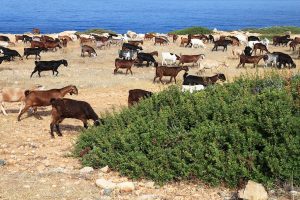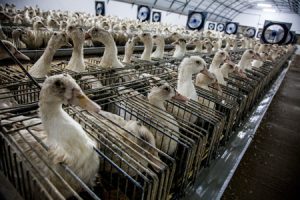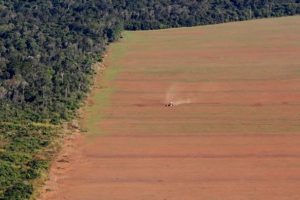Disadvantages of Animal Farming

The other two relevant forms of agriculture covered in this book are mono-cropping, and animal farming. Animal farming is the worst, given that it requires the use of mono-cropping to grow feed for farm animals. This type of agriculture has taken one of the worst human practices, and scaled it to unthinkable proportions.
Humans are not anatomically or physiologically designed to eat animal products. We are not meant to eat animal flesh, it rottens in our digestive track, and causes countless diseases. It is inhumane and immoral. Honey is for bees, milk is for baby cows, eggs are menstrual byproducts that come from the butt-hole-vagina of chickens (the anatomical term is “Cloaca” which in Spanish translates to “sewer”).
The modern animal agriculture industry is an atrocity. This industry takes innocent animals out of their homes and natural habitats, to enslave them. These creatures are caged and transported to concentration camps, where they are tortured, raped, injured, and massacred.
People often refer to the holocaust and other genocides, as the worse human endeavors in history. Sadly, they fail to notice that the animal agriculture industry kills hundreds of millions of cows, chickens, pigs, fish, and other innocent creatures every single year. Some would say that comparing the death of animals to those of humans is erroneous. Once again, that point of view is called speciesism, a point of view similar to racist and sexist perspectives.
Adding insult to injury, the industry processes animal products, and markets them to our entire society as normal and healthy. They advertise their products everywhere, and disguise the atrocities of their actions with sport figures and half-naked women. They buy the votes of politicians and medical practitioners, and corrupt our entire society, spreading blood, death, and disease, across humanity.
The animal products industry has more detrimental effects than most people realize. The major one being the amount of pollution it creates by transporting, processing, and disposing the poison this industry sells. The most common byproduct the industry produces is methane. This gas is expelled into our atmosphere every time a cow farts or chews on grass, day after day, until the moment of their death.
The United States Environmental Protection Agency reported that in 2015, methane accounted for 10% of U.S. greenhouse gas emissions. The agency explains that methane emissions result from livestock and other agricultural practices, from the production and transport of coal, natural gas, oil, and the decay of organic waste in municipal solid waste landfills. (1)
The agency also adds that “domestic livestock such as cattle, buffalo, sheep, and goats, produce large amounts of CH4 as part of their normal digestive process”. They explain that when animals’ manure is stored or managed in lagoons or holding tanks, CH4 is produced. They also confirm that “when livestock and manure emissions are combined, the agriculture sector is the primary source of CH4 emissions.” (2)
You may think this ain’t such a big deal, considering that methane emissions add up to “just” 10% of greenhouse gasses. That is a relatively small number compared to the 82% that carbon dioxide accounts for. However, the agency reports that “pound for pound, the comparative impact of methane is over 25 times greater than carbon dioxide over a 100-year period”. (3) The good news is that we can easily get rid of most of the methane emissions resulting from animal farming, if we give up eating animal products.
Previous Section:
Next Section:
Acknowledgments
Thank you for reading!
Please donate to help us publish this book.
PayPal: trevesbruno@gmail.com
Venmo: @Bruno-Treves
Sources:
(1) https://www.epa.gov/ghgemissions/overview-greenhouse-gases
(2) https://www.epa.gov/ghgemissions/overview-greenhouse-gases#methane
(3) https://www.epa.gov/ghgemissions/overview-greenhouse-gases#methane



